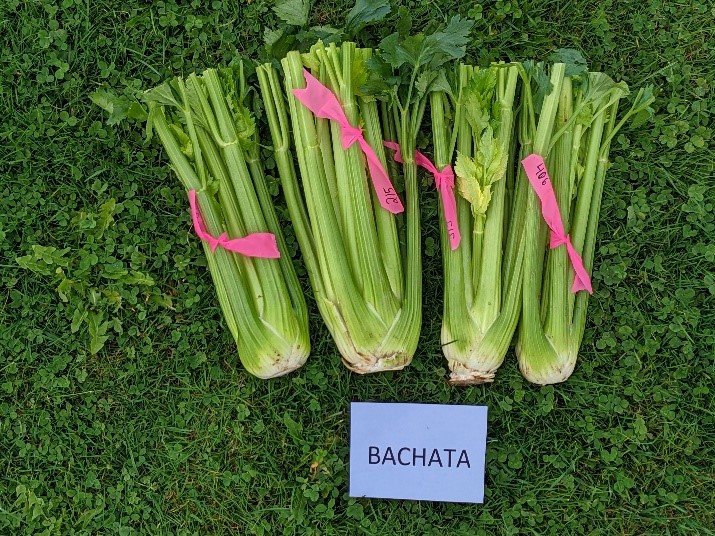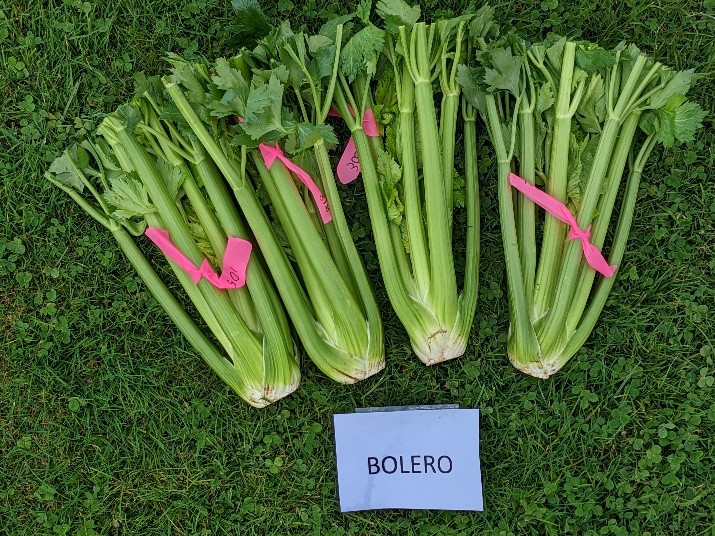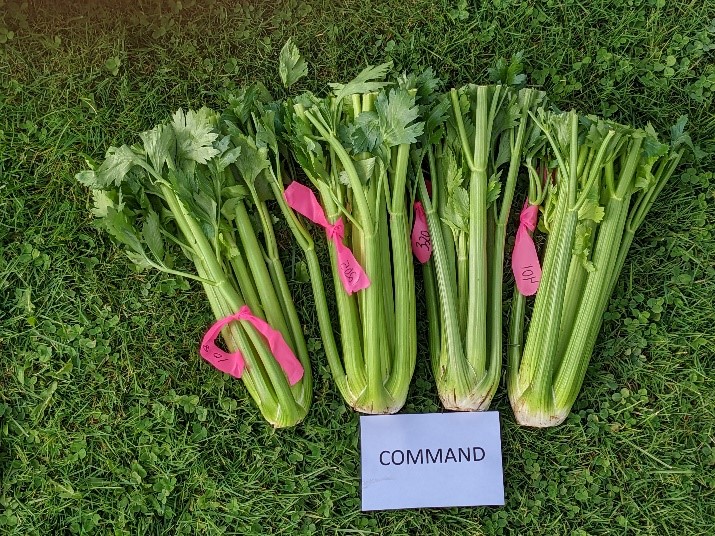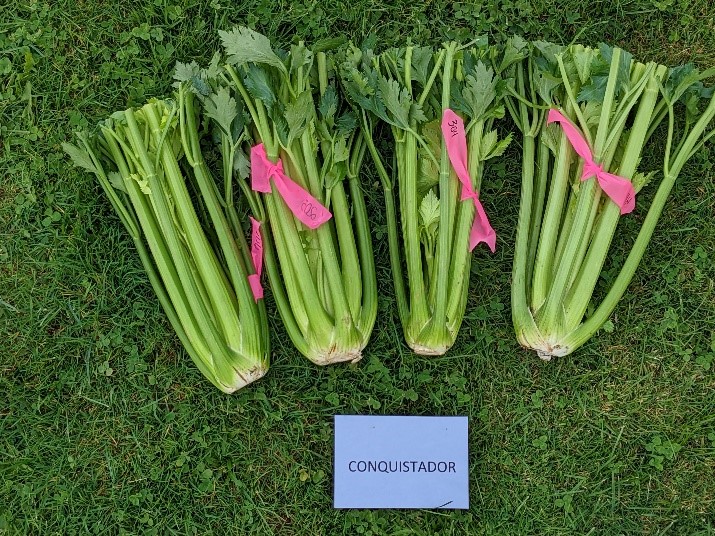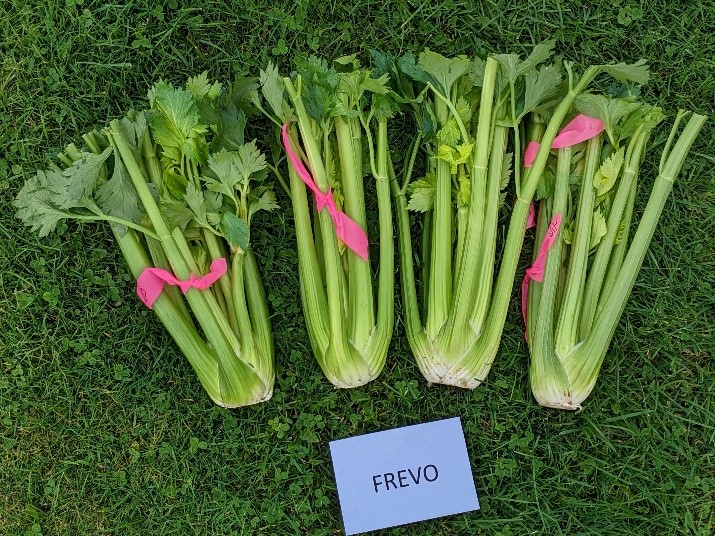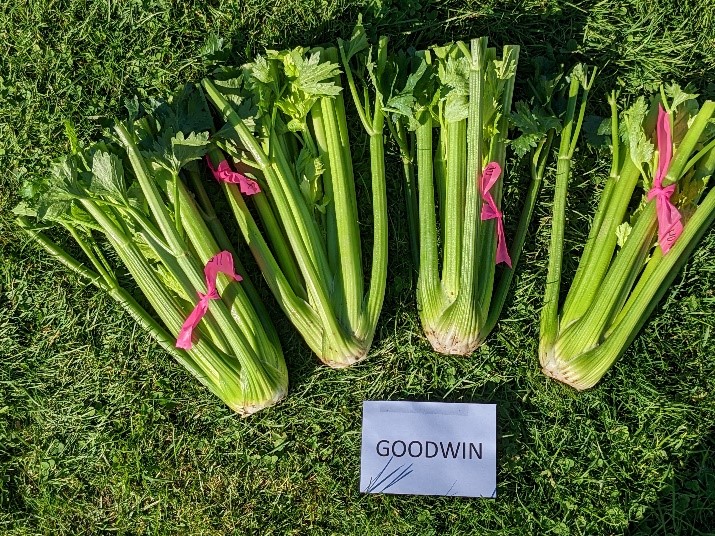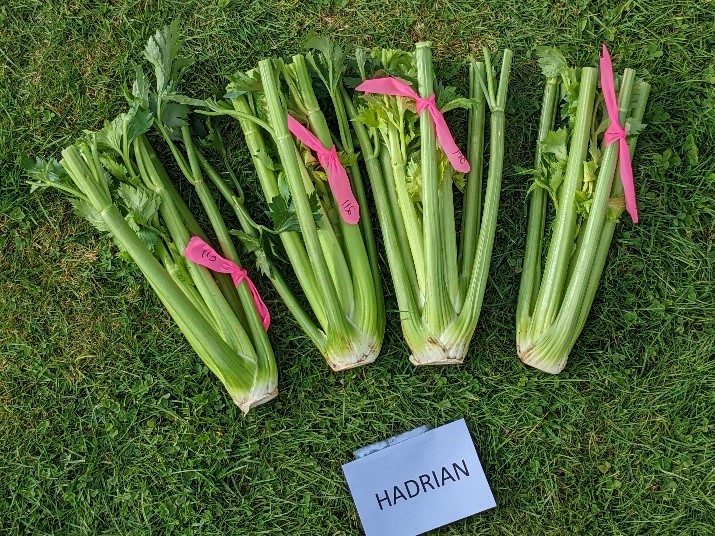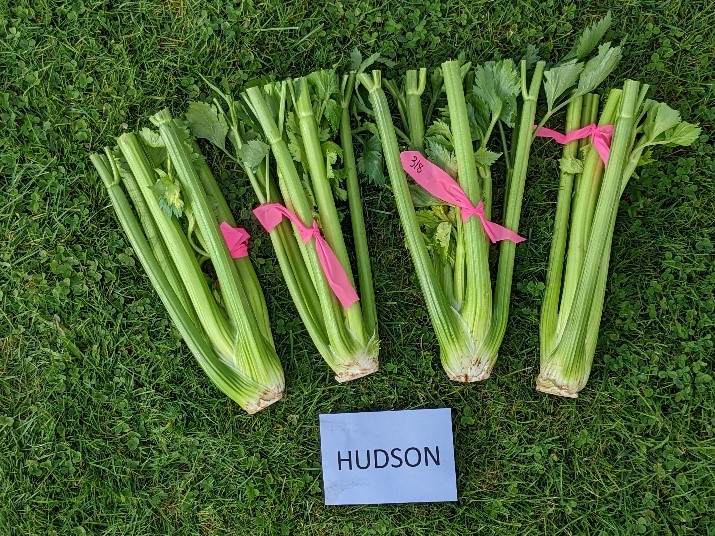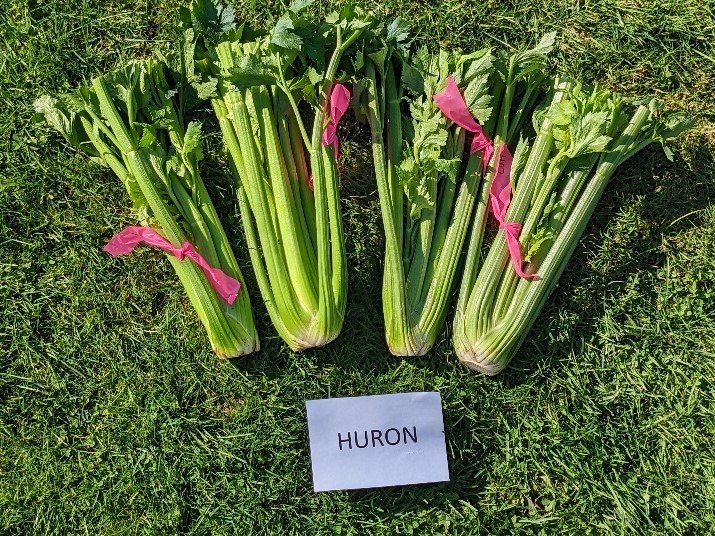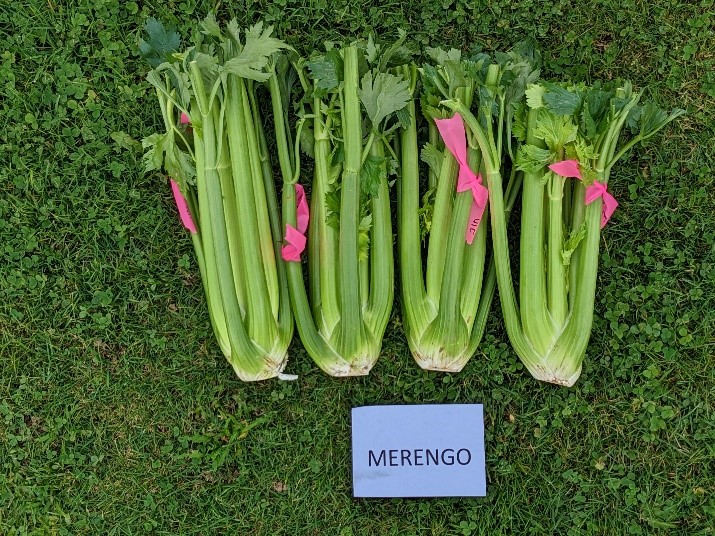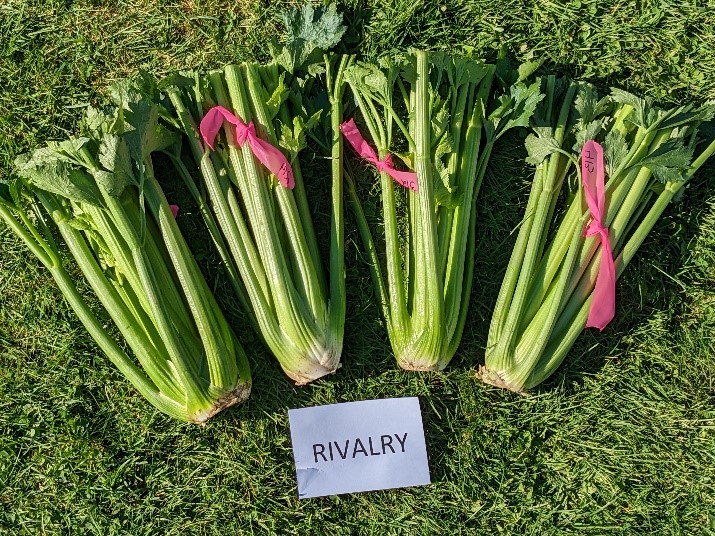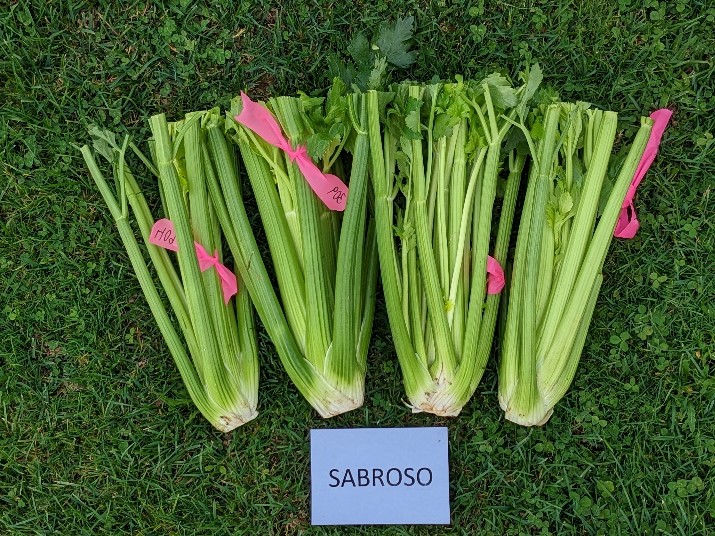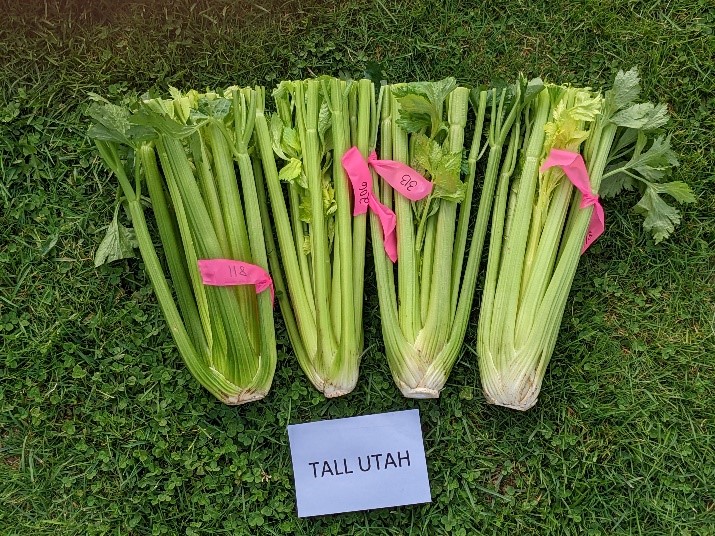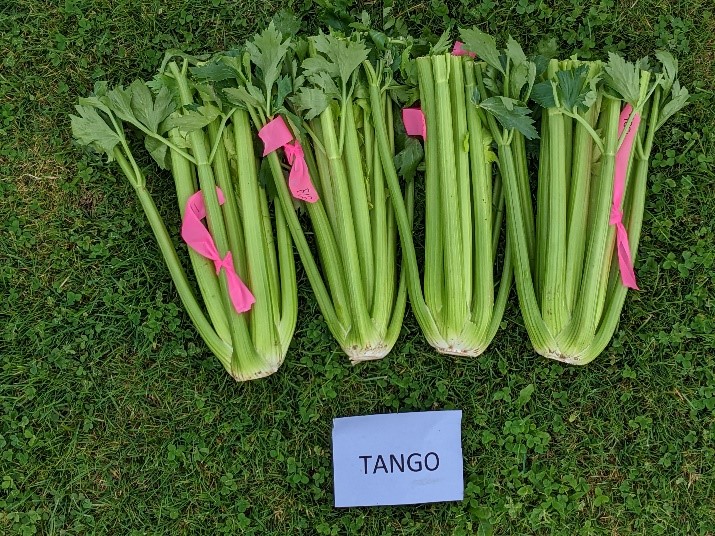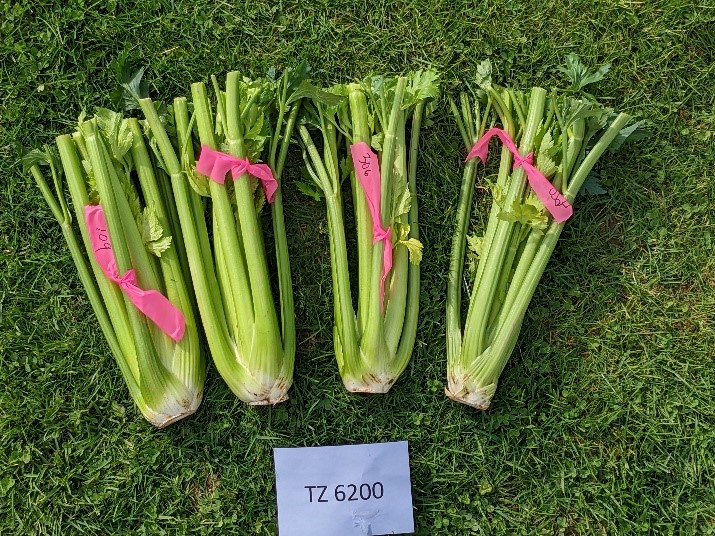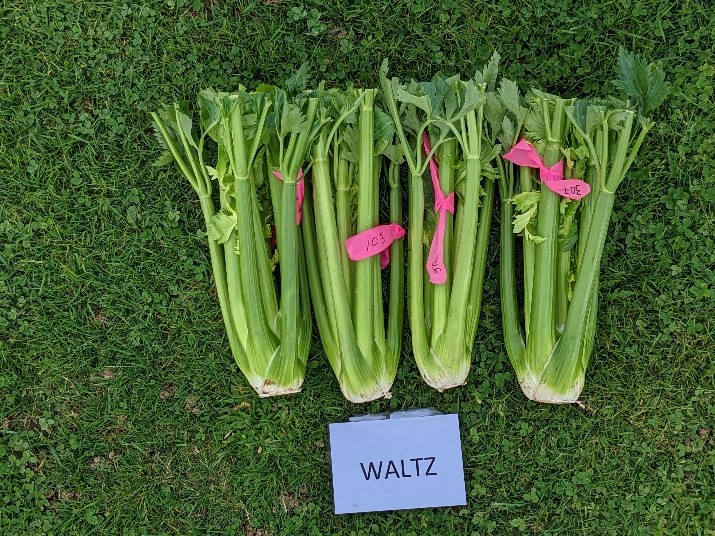Celery Evaluations: 2022 Research Report
Peyton Ginakes, University of Maine Cooperative Extension Research Associate
Mark Hutton, University of Maine Cooperative Extension Vegetable Specialist
David Handley, University of Maine Cooperative Extension Small Fruit & Vegetable Specialist
The second year of a celery trial was conducted at University of Maine’s Highmoor Farm in 2022. The purpose of the evaluations were to develop celery cultivar and management recommendations for Maine farmers, and to enhance the quality and production of Maine-grown celery. Twenty-one celery cultivars were compared for their yield, quality characteristics, and storage potential. A subset of high-yielding, high-quality cultivars were additionally compared for eating quality. Finally, a separate trial was conducted to compare the effect of three different plastic mulches on celery production.
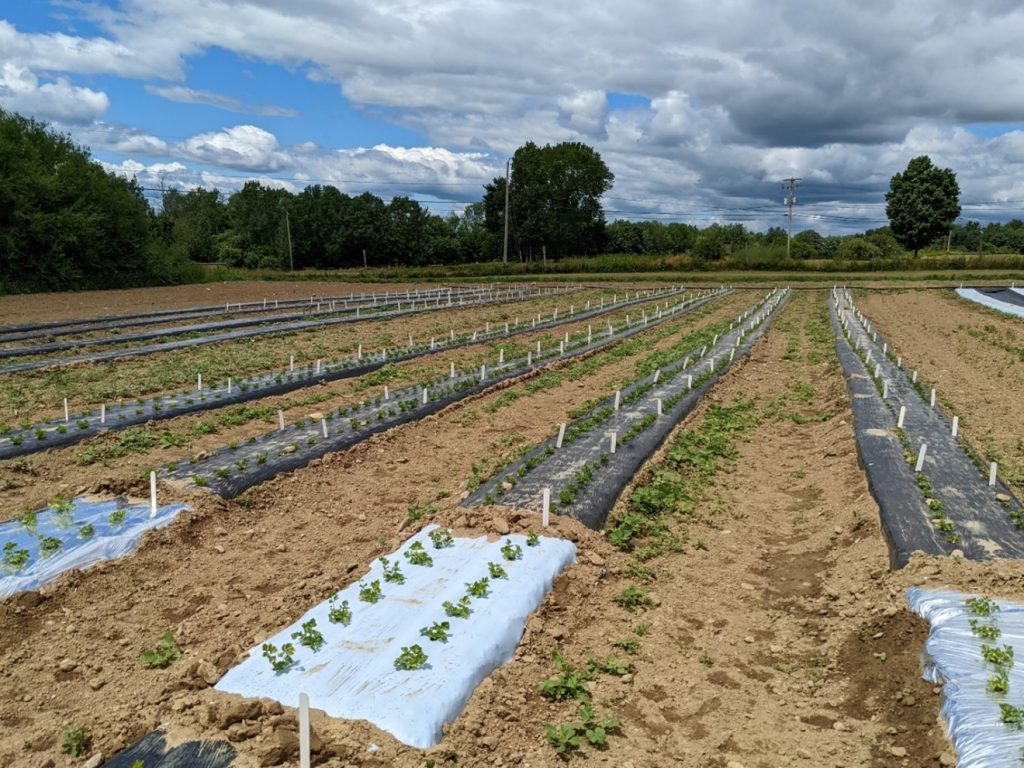
Seedling Production
Celery for all trials was seeded into 128-cell trays filled with ProMix BX + Mycorrhizae media on April 13 using a vacuum seeder, and placed on 70 ˚F heating mats. Seedlings were grown in a greenhouse until planting in the field. Cells were thinned to one plant each nearly two months later, on June 7, and fertilized with 1 Tbsp/gal of 12-45-10 Nutriculture Spoon-Feeding soluble fertilizer on June 14.
Mulch Trial
Three mulches were evaluated for their effect on celery production: 1) black plastic, 2) white on black biodegradable plastic, and 3) reflective on black plastic. Plastic mulches are helpful for reducing weed pressure in celery, as it is a slow-growing crop. Additionally, our 2021 research comparing black plasticulture to bare ground celery production suggested that while plastic mulches may create an environment that is unfavorably stressful for celery, they may also conserve soil nutrients over the long growing season. Therefore, we hypothesized that growing celery on white and reflective plastic mulches would produce greater yields compared to black plastic, primarily due to their soil temperature mediating effects.
The field was fertilized with 500 lb/ac of 10-10-10 before mulches were installed on raised beds. Mulches were arranged in a randomized complete block design with four replications. Each plot was 5.3 feet long, containing 14 plants in double rows, with an 8” in-row spacing and 14” between rows. Celery seedlings (cv. Merengo) were transplanted by hand on June 22 (70 days after seeding) in the greenhouse. Plants were watered in with 1 cup of 12-45-10 Nutriculture Spoon-Feeding soluble fertilizer (1 Tbsp/gal) immediately after transplanting. Plots were irrigated as needed through two rows of drip tape, kept free of weeds, and fertigated once on August 1 (40 days after transplanting) using the same Nutriculture soluble fertilizer.
Four plants from each plot were harvested on September 30 (100 days after transplanting). Plants were initially weighed, and then outer petioles were removed until plants were in a marketable condition and weighed again. Plants were then topped to 14” and weighed for a final time. These data were collected to reflect plant yields in different marketable conditions; simply trimmed bunches may be suitable for farm stands, CSAs, etc., whereas topped plants are preferable for wholesale markets.

Planting celery into white on black plastic mulch increased untrimmed bunch weight relative to black plastic by 38% (Table 1). Reflective mulch also had greater bunch weights than black plastic, but this increase was not statistically significant. Further, while average trimmed and topped weights of these alternative mulches did increase numerically relative to black plastic, these differences were also not statistically significant.
a Values in a column followed by the same letter are not different (p < 0.05).
Cultivar Evaluations
Twenty-one celery cultivars were grown in a randomized complete block design field trial with four replicates. Seedlings were transplanted using a water wheel transplanter (Nolt’s, model P150) into black plastic-mulched raised beds that had been prepared with 500 lb/ac of 10-10-10 fertilizer. This planting system was chosen for its widespread use and practicality. Plots were the same size and used the same spacing and cultural management practices as the mulch trial.
Four plants from each plot were harvested on two dates: September 21 (91 days after transplanting) and October 5 (105 days after transplanting). Untrimmed, trimmed, and topped yield data were collected in the same fashion as in the mulch trial. Data were analyzed using harvest date as a main plot factor and cultivar as a subplot factor (Table 2).
Bachata, Rivalry, Stalker, and Tango consistently produced the greatest yields. While celery may not be sold by weight in some markets, these data may reflect how well-developed bunches appear at harvest as well. Command, Conquistador, and Tall Utah all produced the smallest plants. In addition, Victoria and Balada yielded poorly when topped, indicating they may not be suitable for wholesale markets in Maine.
Tall Utah, TZ 6200, and Victoria needed the most trimming in order to achieve a marketable appearance, while Stalker required the least. The latter is likely the reason Stalker produced high trimmed and topped yields. Importantly, nearly 30% more trimming was required across all cultivars in the second harvest relative to the first. Because there was no major yield gain of processed plant weights between harvests, and because bunch weight may not be important for some markets, it may be prudent to harvest plants on the early side in order to reduce labor needed for trimming plants to marketable condition.
a Values in a column followed by the same letter are not different (p < 0.05).
The proportion of the trimmed plant weight that is removed when topped to 14” is important to consider in the context of one’s market. Tall plants can be impressive at a farm stand or useful for stalking, but may be wasteful for a wholesale market, for instance. Balada, Kelvin, and Sabroso lost the greatest proportion of their trimmed weight when topped. Cultivars that lost the smallest proportion of their trimmed weight due to topping include Command and Conquistador, both of which had notably low bunch yields overall, as well as Waltz. Tango, Rivalry, and Stalker were compact cultivars that yielded well, and were able to retain more of their weight when topped than those listed above (Balada, Kelvin, and Sabroso).
Visual Quality Evaluations
Trimmed and topped plants from the second harvest were retained after collecting yield data for quality evaluations. Cultivars were visually rated for the following qualities: color, smoothness, pithiness, stringiness, and bolting. All characteristics were ranked on a 1-5 scale except for bolting, which was recorded as a proportion of plants with any seed stem elongation (Table 3).
a Color ranked on 1-5 scale; 1 = blanched, 5 = dark green.
b Smoothness ranked on 1-5 scale; 1 = heavily ribbed 5 = barely detectable ribbing.
c Pithiness ranked on 1-5 scale; 1 = hollow interior, 5 = no pithiness.
d Stringiness ranked on 1-5 scale; 1 = many strings and no clean snap, 5 = no strings and clean snap.
e Bolting is ranked as the proportion of four plants with any seed stem elongation.
f Values in a column that are followed by the same letter are not different (p < 0.05).
Celery color was ranked with 1 as having a blanched appearance, and 5 being a medium-dark green. With only two exceptions, the 21 cultivars evaluated fell between 2.5 and 3.5. This range reflects the bright medium green shade preferred by many consumers; blanching and the appearance of blanched celery is out of vogue. Victoria was lightest in color, while Bolero, Fandango, and Stalker were the darkest.
Petiole smoothness was ranked with 1 as being heavily ribbed and 5 as having barely detectable ribbing. There is no current ideal smoothness rating, and some people prefer ribbed stalks, while others like stalks smooth. Bolero, Hadrian, and TZ 6200 were the smoothest cultivars, while Sabroso and Stalker were the most ribbed.
Petiole pithiness was ranked with 1 being hollow, 3 having some pithiness but no breakdown, and 5 having no pithiness. A pithiness rating of 3 is the minimum for being marketable. Tall Utah was the pithiest cultivar and the only one with an average pithiness that rendered it unmarketable. Conquistador, Frevo, Hadrian, Hudson, and Victoria were the least pithy.
Stringiness was ranked by snapping petioles in half widthwise; a 1 denotes many strings without a clean snap, and a 5 snapped cleanly with no trailing strings. While higher rankings are preferable for fresh eating, stringiness to some extent is not necessarily bad for cooking or processing. Overall, stringiness ranged from 2.3 to 3.9 across all cultivars and none were significantly different from one another.
Bolting in celery can occur when exposed to low temperatures. When plants are only beginning to bolt, they may remain marketable; however, as the seed stem elongates it can split the bottoms of petioles and render bunches unmarketable. This can often be allayed by simply harvesting earlier. For instance, we observed a substantial amount of bolting at our second harvest, but not in our first (14 days earlier). There were no significant differences in bolting across cultivars.
Eating Quality Evaluations
Celery grown in Maine must be well-adapted to the variable growing environment in order to be palatable to consumers. Cultivars that are not adapted to such growing conditions are often pithy, tough, and strong in flavor. To ensure good eating quality, we selected four high-yielding, visually appealing cultivars to compare against a store-bought sample: Bachata, Goodwin, Rivalry, and Tango. Bunches of each cultivar were saved from the second harvest and stored in a walk-in cooler (34 ˚F) until they were transported to the Sensory Analysis Lab on the University of Maine Orono campus. There, they were cut into 2” samples, anonymized, and given to volunteer participants to evaluate sensory attributes. Participants rated their liking of general appearance, color, aroma, texture, flavor, and overall liking of each sample on a 9-point scale (Table 4).
Forty-eight people participated in celery testing. Most participants reported eating celery at least 1-2 times per month (71%), consuming celery raw (48%), and preferring celery for its crispness (42%). Grocery stores were the most commonly reported place for purchasing celery (44 of 48). However, 75% of participants reported that they considered buying locally-grown vegetables as moderately, very, or extremely important, and this was supported by 27 participants who reported buying celery from farmer’s markets, three from food cooperatives, and one from a farm share.
a Hedonic scale: 1 = Dislike extremely; 2 = Dislike very much; 3 = Dislike moderately; 4 = Dislike slightly; 5
= Neither like nor dislike; 6 = Like slightly; 7 = Like moderately; 8 = Like very much; 9 = Like extremely
Values followed by an asterisk (*) are different from the store-bought control (p < 0.05) in that attribute.
Overall rankings of the four cultivars subjected to preference testing did not differ from the store-bought sample, indicating that all were of widely-accepted quality standards. In fact, the appearance and color of Bachata was more liked than the store-bought control. Texturally, Goodwin and Rivalry were less liked than the store-bought sample.
Storage Trial
A subset of harvested plants from each plot and each harvest was set aside to evaluate differences in storage life. Plants were individually weighed, put into waxed boxes, and placed in a 34 ˚F cooler. At two and four weeks after harvest, plants were removed, weighed, trimmed to remove degraded petioles and rot as needed, and weighed again to measure mass loss due to both respiration and trimming (Table 5).
No difference in mass loss was found between cultivars after the initial two weeks of storage. However, plants harvested earlier (September 21) lost more mass than those harvested two weeks later. This was due entirely due to water loss via plant respiration, not trimming of petioles.
After four weeks in storage, differences in mass retained were apparent between both harvest dates and cultivars. Bachata, Balada, Conquistador, Fandango, Goodwin, Hadrian, Kelvin, Tall Utah, TZ 6200, Victoria, and Waltz all stored better for four weeks when harvested September 21 relative to October 5. These cultivars lost an average of 20% more weight when harvested late, and this difference can be attributed to trimming away rotten petioles (not water loss). Of plants harvested early, there was no difference in mass loss between cultivars. When harvested late, however, Stalker and Tango retained more mass than Hadrian and Victoria. These differences can also be attributed to differences in rot and subsequent trimming rather than respiration.
a Values in a row that are followed by different capital letters are significantly different (p < 0.05).
b Values in a column that are followed by the same lowercase letter are not different (p < 0.05).
Cultivars
Acknowledgements
This work was funded in part by the USDA-NIFA Specialty Crop Block Grant program as administered by the Maine Department of Agriculture, Conservation, and Forestry, and additionally supported by the University of Maine Agricultural and Forestry Experiment station, the Maine Vegetable and Small Fruit Growers Association, and Hatch ME022320. Bejo Seeds and Tozer Seeds generously donated materials for this project. We are grateful for assistance from Greg Koller and Patricia McManus, and field assistants Jonathan Brenner, June Foyt, Ethan Handley, Lydia Handley, Lee Lavoie, Abigail Lucas, Brooke Martin, and Karla Mendoza.
For any questions or comments on this research, please contact Peyton Ginakes at peyton.ginakes@maine.edu or Mark Hutton at mark.hutton@maine.edu or (207)933-2100.
Download and Print:
Information on this website is provided purely for educational purposes. No responsibility is assumed for any problems associated with the use of products or services mentioned in this website. No endorsement of products or companies is intended, nor is criticism of unnamed products or companies implied.
In complying with the letter and spirit of applicable laws and pursuing its own goals of diversity, the University of Maine System does not discriminate on the grounds of race, color, religion, sex, sexual orientation, transgender status, gender, gender identity or expression, ethnicity, national origin, citizenship status, familial status, ancestry, age, disability physical or mental, genetic information, or veterans or military status in employment, education, and all other programs and activities. The University provides reasonable accommodations to qualified individuals with disabilities upon request. The following person has been designated to handle inquiries regarding non-discrimination policies: Director of Equal Opportunity, 5713 Chadbourne Hall, Room 412, University of Maine, Orono, ME 04469-5713, 207.581.1226, TTY 711 (Maine Relay System).

